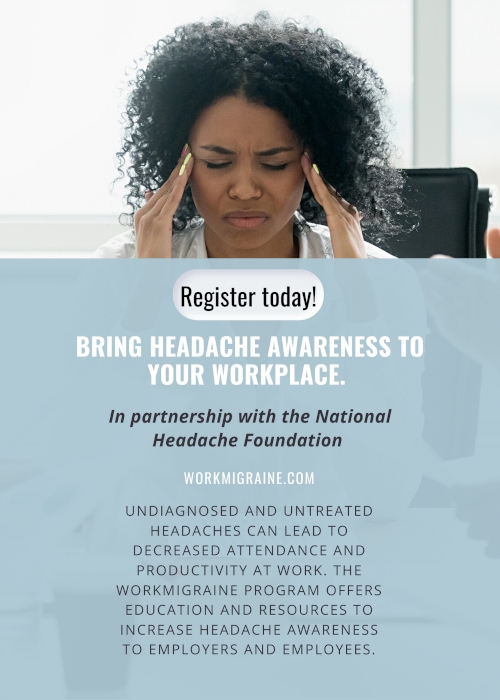Hepatitis: Find The Missing Millions
Thursday, July 2nd, 2020
Every year on July 28th, we observe World Hepatitis Day. This is a day to raise awareness and connect those infected with proper care. It is estimated that nearly 300 million people are walking around infected, completely unaware. The main way to remedy this issue is to spread awareness, encourage people to get tested, and receive treatment.
Prevention
The goal is to eradicate all forms of viral hepatitis by the year 2030. While we’ve seen a decrease in diseases like tuberculosis and HIV, cases of hepatitis have continued to rise. The CDC’s main tool of prevention has been to encourage vaccination. Both hep A and B have vaccines, with hep B being most commonly spread from an infected mother to her child during birth. This is why the hep B vaccination is recommended for infants before leaving the hospital.

Hep C, D, and E do not yet have vaccines. However, hep C can be treated in 90 percent of cases. Hep D is only contracted when an individual is already infected with hep B. So vaccinating against hep B can also protect against hep D.
Types of Hepatitis
Viral hepatitis comprises types A, B, D, D, and E. These are infectious diseases that spread easily from person to person and lead to liver disease.
Hepatitis A – Hep A is rarely fatal, but does cause some serious symptoms. In the US it is spread through close personal contact with someone who is infected. Poor sanitation and hygiene can also lead to its spread worldwide.
Hepatitis B – This virus is the one most commonly spread from mother to infant at birth. This is why it is recommended that all infants receive the vaccine as soon after birth as possible. Hep B can lead to cirrhosis of the liver and liver cancer.
Hepatitis C – There is currently no vaccine for Hep C, although 90% of cases are able to be cured. This virus is usually transferred through infected blood, by the sharing of needles or improper medical treatment. The research for a vaccine is ongoing.
Hepatitis D – Hep D can only be contracted by someone already infected with Hep B. So even though there is no vaccine for it, the best way to prevent it is by being vaccinated for Hep B.
Hepatitis E – Hep E is typically contracted from contaminated drinking water, usually in areas with poor sanitation and water filtration. It is most deadly to pregnant women.
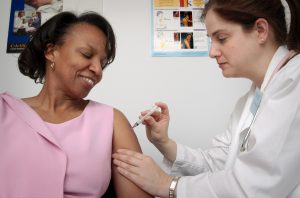
How to Get Tested
So while millions are walking around infected with hepatitis, they are unknowingly endangering themselves and others. We need to get those who are infected tested and connected to treatment. How do you get tested? A simple blood test can be performed by your doctor. This will determine what type of virus you may have as well as its severity. The doctor may also examine your liver to look for signs of inflammation.
Someone can be infected with the virus and not show any symptoms for years. So it’s important to get tested if you fall into any one of these categories:
- Baby boomers (those born between 1945 and 1964) are much more likely to be infected.
- Anyone who has had a blood transfusion or organ transplant prior to 1992
- Anyone who has ever (even once) injected illegal drugs or shared needles.
- People with tattoos.
- Anyone born to someone infected with a hepatitis virus.
Treatment Options
In general, most forms of hepatitis are either treatable or resolve on their own with rest and proper care. For acute hep C and chronic forms of both hep B and C, an antiviral medication may be prescribed. There are no medications available at this time to treat hep D or E. If extensive damage is done to a person’s liver, a liver transplant may be required.

For more in-depth information about hepatitis, its symptoms, and treatment options, please visit the links in our Wellness Observance Calendar. We have the most comprehensive Wellness Calendar available and we offer it to you as a free download for your resource!
UV Safety Tips: Simple Ways to Protect Yourself from Harmful UV Rays
Tuesday, June 23rd, 2020
We all know we need to protect ourselves from the sun. UV radiation can be harmful to our skin in multiple ways. It speeds up the aging process, suppresses the immune system, can cause sunburn, and increases our risk for skin cancer. Even synthetic UV rays from tanning beds can cause harm to our skin often creating an even higher risk of skin cancer.
During the month of July, we observe UV Safety Month. Throughout the month we will spread awareness about various ways to protect ourselves from harmful UV rays. Are you providing yourself and your loved ones with full protection? We want to share a few tips to make sure you aren’t missing anything.
Seek Out the Shade

During the Sun’s most direct rays, between 10 am and 4 pm, it’s important to seek out the shade when possible. If there’s no shade available, bring your own! A broad-rimmed hat or ball cap can provide extra shelter from the sun for your face. The skin on your face is one of the most vulnerable to the sun since it is always exposed.
Remember that UV rays may still be able to reach you, even in shade. This is most likely when you are near reflective surfaces like sand, snow, or water. So wear your sunscreen even in the shade.
Understanding SPF: Sun Protection Factor

What SPF should you be looking for in your Sunscreen? What does it even mean? SPF or Sun Protection Factor indicates how long you will be protected in the Sun. If you wear an SPF of 10, your skin will take 10 times longer to burn than it would if left unprotected. However, the FDA recommends using a minimum SPF of 15 and most doctors recommend a 30 SPF minimum.
No matter what SPF you choose, experts also say you should reapply every 2 hours. More frequent reapplication may be necessary when swimming or excessively sweating.
It’s also important to note that SPF only protects against UVB rays. UVB radiation damages the skin causing sunburn. But UVA rays penetrate deep into the skin causing aging and also posing the risk of skin cancer. Choosing a sunscreen labeled, “broad spectrum” or “full-spectrum” will protect against both UVA and UVB rays.
Don’t Forget these Hidden Spots

It’s easy to remember that we need sunscreen on our shoulders, back, arms, and legs. What about those places we commonly miss? Be sure to protect your ears, the part in your hair, and the tops of your feet. Lips are another important, but easily forgotten part of the body to protect. Wear a lip balm with SPF and reapply frequently.
Harmful UV rays are partly responsible for vision-related problems like macular degeneration and cataracts. So be sure to protect your eyes with sunglasses specifically labeled with 99% UV protection.
More UV Safety Tips
For more information on UV Safety Month, visit our Wellness Observance Calendar. You can also receive a free download of our entire 2020 Calendar to stay up to date on future Wellness Observances throughout the year.
COVID-19: What We Need to Know
Saturday, March 14th, 2020
The world has been affected by this coronavirus outbreak in a way that none of us expected a few weeks ago. With the widespread reach of the media and social networks, we have the double-edged sword of a surplus of information. It can be difficult to wade through it all and make sense of what it means. There are two extreme ends of the spectrum, oscillating between extreme panic to an almost blase attitude. There is some real cause for concern, but we’d like to help the situation by compiling some helpful facts and tips for how to handle our current situation.

Preventing the Spread of Disease
The disease has been found to spread most easily from close contact (within 6 feet) from person to person. The transfer of the virus can occur from unprotected coughing or sneezing. The CDC has been extremely clear in describing the measures we can all take to prevent the spread of this highly contagious virus.
- Wash hands frequently, especially after using the bathroom, coughing or sneezing, touching any potentially contaminated surfaces.
- Keep your unwashed hands away from your face where germs can obtain easy entry into your body.
- Stay home when you are sick.
- Keep away from people who are infected with the virus.
- Put distance between yourself and large groups of people if there is a spread in your community.
- Wear a facemask ONLY if you are sick or caring for a sick person who may be unable to wear one.
- Clean and disinfect frequently touched surfaces.

As employers, how can we keep our workplaces healthy?
- Encourage employees to stay home when sick by providing flexible sick leave policies.
- Enable as much work to be done remotely as possible during community outbreaks.
- Separate sick employees who may become sick during the workday.
- Encourage routine hand washing.
- Perform thorough routine cleaning of frequently touched surfaces.
- Educate employees on symptoms or coronavirus.
Symptoms of Coronavirus
The coronavirus is a respiratory illness exhibiting the following symptoms. Keep in mind that people may respond to the virus in different ways. These symptoms may appear up to 14 days after exposure:
- Fever
- Cough
- Shortness of breath
Most cases of the virus have been mild and recoverable. However, there are some who are at increased risk for the most severe cases, potentially becoming fatal. Those at high risk include the elderly and those with preexisting conditions such as heart disease, diabetes, and lung disease. If you or someone close to you fit into the high-risk category, take extra precautions.
If you do exhibit symptoms don’t go to the doctor. Call your doctor and describe your symptoms and possible exposure to the illness. They can advise you if you need to be tested and tell you what your next steps should be.

Be a Kind Human
Remember that we are all in this together. Even if you are not at a high-risk for infection, you may unknowingly be in close contact with people who are. Consider the people around you. Take all the precautions advised by the CDC to prevent or lessen a widespread outbreak in your area.
Be considerate when stocking up on supplies and only purchase what you need. Leave some for others rather than overbuying out of panic or fear.
Keeping Anxiety at Bay
In order to keep anxiety at bay, it may be best to limit your exposure to social media outlets. Protect your mental health by keeping things light, talking to your loved ones and staying focused on the positive. Even though this virus isn’t well known, much progress has been made already. The mass cancellations are for our safety and prevention and should be comforting more than inciting fear. It’s a means of stopping the spread of the virus so that it stays under control.
For much more specific information on the coronavirus and how to stay healthy, especially as businesses and employers, visit the official CDC website.
Oral, Head & Neck Cancer Awareness
Sunday, February 23rd, 2020
In 2020, we observe Oral, Head and Neck Cancer Awareness Week from April 13th-19th. Since 71 percent of Americans have never been examined for these types of cancers, free screenings are offered during the Awareness week. Help us spread awareness by promoting the free screenings and spreading knowledge about symptoms with individuals who may be at risk.
Who is at Risk for Developing Oral, Head and Neck Cancer?

Those at risk include anyone who smokes or uses tobacco. Tobacco use accounts for 85% of all cases of oral, head and neck cancers. Excessive alcohol intake also puts you at risk and the combination of the two increases your risk dramatically.
Human papillomavirus is another common cause of cancer, especially of the throat. Epstein-Barr virus usually remains dormant in infected individuals. It can exhibit itself in the form of mono and has also been associated with nasopharynx cancer.
Men are 2-3 times more likely to develop some form of oral, head or neck cancer than women. Poor nutrition lacking in A and B vitamins can also increase your risk. People with poor dental hygiene are at an increased risk as well as sufferers of GERD (gastroesophageal reflux disease).
Symptoms
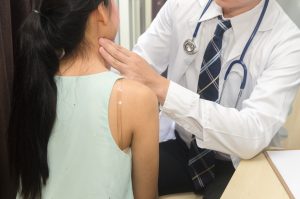
Oral, head and neck cancers are found the squamous cells that line the head and neck. Symptoms can exhibit in the form of a lump in these areas. They may also cause a longterm sore throat or persistent fever. Other symptoms include difficulty swallowing and a change in voice.
Any of the above symptoms could also be indicators of a less serious condition. If you have any of these symptoms, it’s best to be seen by a medical professional to determine the exact cause.
Prevention
Early diagnosis is imperative for preventing the development of these cancers. This is why the free screenings offered are so important to take part in. Last year hundreds of free screenings were offered in hospitals and medical centers across the country and the world. Free screenings can be found throughout the year, but the most availability occurs during the awareness week.

Simply ceasing tobacco use is a great way to prevent cancer from developing. Our bodies have the amazing ability to even reverse the damage that has already been done. Younger, healthy individuals have been known to develop oral, head and neck cancers more as a result of HPV. Receiving vaccination against the virus is essential to preventing these cancers.
How To Spread Awareness
Visit the Head and Neck Cancer Alliance to find out more about how to host a free screening event. You can also search for free screening sites near you on their website.
In addition to attending a free screening, there are other events offered like runs, education workshops, galas, and silent auctions. It doesn’t take much to share a social media post or to communicate your own story with your sphere of influence. Do what you can to promote health and oral, head and neck cancer awareness. Together we can save lives.
Healthy Feet on the Job
Wednesday, February 19th, 2020
Our feet do the grunt work by supporting our entire bodies every day. They carry us from place to place from infancy through adulthood covering upwards of 100,000 miles. Our feet are the very foundation for our bodies but are typically ignored until there’s a problem. Once there’s a problem, it can affect our entire body’s overall health. Since our feet work so hard for us, why don’t we take care of them before any problems begin? Let’s go over some ways we can care for our feet and keep them healthy as they carry us through both our workday and life.
Proper Footwear
Wearing shoes with little to no arch support can wreak havoc on your body. Not only does a good supportive shoe provide a steady foundation and balance, but it also contributes to your overall activity level. Your arch comes under the most strain as you stand and walk. Without support, you may experience back pain, foot pain, and even headaches or stomachaches.
It can be challenging to find proper footwear when you work in an environment that requires more formal attire. Purchase a good shoe insert to make even the least supportive shoes more foot health-friendly.
If you can wear a shoe with laces at work, choose one with multiple eyelets. The more a shoe has, the more it can conform to the shape of your foot, providing the best support.
Moisturize
There are plenty of lotions and creams out there that are touted as the best for your feet. Any of them will do. The real trick to moisturizing your feet is to make sure you are first exfoliating. Get rid of any dead skin cells so that your dry feet will be ready to receive new moisture.

You can use a simple washcloth after soaking your feet, or a loofah or pumice stone for those extra dry, callused areas. Adding some Epsom salt to your bath can help soften the skin on your feet, making it easier to remove any dead skin.
Follow your exfoliation with a lotion or petroleum jelly to seal in moisture. Most of all, be consistent. Your feet crave moisture daily. Make sure your body is also hydrated from the inside by drinking plenty of water and eating a diet rich in Omega fatty acids.
Good Foot Hygiene
It’s easy to ignore our feet when it comes to hygiene. They’re typically covered inside a shoe, so who’s really going to see them? They’re also a long way down there! May we suggest you take the small extra effort to pay special attention to your feet? Here are some issues that may arise from poor hygiene and how you can prevent and address them:
- Ingrown toenails – ingrown toenails can be painful and uncomfortable. Be sure to keep your toenails trimmed, but not too short! Trim your toenails straight across rather than rounding the edges. Maybe most important, choose shoes that fit your foot properly! Shoes that are too tight can contribute to an ingrown toenail. Your toes should be able to wiggle freely inside.
- Smelly feet/shoes – This is a common problem for shoes that you may wear daily. Feet sweat and when they are inside a sock and shoe for over eight hours a day, that doesn’t leave much room for air circulation. Sometimes you are left with a shoe that stinks no matter what you do! In order to prevent those perpetually smelly feet, try to alternate between at least two different pairs of shoes for work. This allows one pair to completely dry out for over 24 hours. It won’t stop your feet from sweating, but it should allow the smell to decrease. Also, wear cotton socks to wick sweat away. Socks made of other materials may trap moisture in and worsen the issue. Choosing leather shoes over plastic or other synthetic material can also promote more air circulation to your feet.

- Infections/Itchy Feet – there are many different causes for itchy feet and not all of them relate to hygiene. However, one that does is a fungal infection we all know as “athletes foot”. Athlete’s foot can develop if your feet sweat and you’re wearing shoes that are too tight. Make sure your shoes fit properly and that you change out of sweaty socks as soon as possible. Even washing your feet with antibacterial soap can be helpful, paying close attention to in between your toes.
- Dry, cracked heels – Feet tend to be exceptionally dry. If you’re someone who spends a lot of time on their feet, your dry heels may even crack. These cracks leave your feet open and susceptible to infection. Use a thick moisturizer on your feet each night before bed and especially after washing to lock in moisture. Resist the urge to be barefoot as much as possible since it can lead to drier feet and the potential for infection.
April is Foot Health Awareness Month! Visit our National Wellness Observance Calendar for more resources on Foot Health as well as a FREE Calendar download. See our Wellness Blog on Workplace Wellness for tips on how to bring this education into your workplace.
The Effects of Blue Light On Your Eyes
Monday, January 13th, 2020
There are conflicting reports about the effects of blue light on your eyes. Some studies claim potential damage to the retina by overexposure, while still others insist there’s no effect at all. Since so many of us spend a great deal of time exposed to blue light screens in the workplace, it’s become a significant issue for workplace eye health.

Blue Light & Potential Hazards
It’s important to note that the largest source of blue light comes from our largest light source: the sun! We’re exposed to blue light on a daily basis. We know that light is composed of an entire spectrum of color, as evidenced by the rainbow. The red light being slower and dimmer while the blue light is brighter and moves more quickly. Our technological screens, like TVs, computers, smartphones, and tablets emit a much smaller source of blue light than the sun. So why is there so much concern surrounding blue light and our vision?
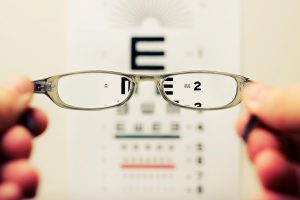
We spend an exorbitant amount of time with our eyes glued to some type of blue light screen. In fact, over the last thirty years, nearsightedness has seen a dramatic increase of over sixty percent! This could be due to the correlating time frame of increased computer usage. The ultimate concern is that so much time staring at blue light may have some very negative effects on our eyes. Some symptoms reported by those with excessive screen use include:
- Dry eyes
- headache
- blurry vision
- eye twitching
- sore, tired eyes
The popularity of blue light glasses has led many to believe they are experiencing relief from these symptoms. While still, other professionals say it’s only a placebo effect. They hold to the fact that there is no real evidence of any negative affect from blue light, but that symptoms are merely from the way technology is used.
Tips for reducing digital eye strain symptoms:
If you find yourself suffering from any of the previously mentioned symptoms, try some of the following solutions.
- Follow the 20-20-20 rule, giving your eyes a break every 20 minutes for a minimum of 20 seconds to scan the room 20 feet away. This gives your eyes a chance to focus on objects further away from the screen and gives relief from the light of the screen.
- Sit at arm’s length (25 inches) from your screen.
- Blink often. We tend to blink less when staring at a computer screen which can make your eyes dry or tired.
- Adjust the settings on your screen. Adjusting the contrast levels of your screen can make staring at your screen easier on your eyes.
- Purchase a matte filter to place over your screens to reduce glare.
- Simply reduce the amount of time spent looking at a screen.

Further study is needed to determine any concrete evidence of blue light leading to retinal damage. But if blue light glasses and other aids seem to provide some relief to your symptoms, there is no harm in using them. They have only yet to be proven medically necessary.
To ensure good eye health, get your eyes checked regularly by an optometrist or ophthalmologist. After age 65 it is recommended that your eyes are examined every 1-2 years in order to catch any early signs of disease. Visit our Wellness Calendar for more information and resources regarding eye health.
Other Eye Health Wellness Articles:
Age-Related Macular Degeneration
Sunday, December 29th, 2019
What is Age-related Macular Degeneration (AMD)?
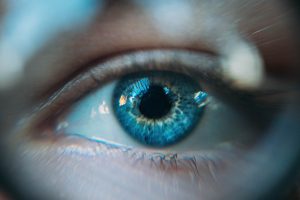
Age-related Macular Degeneration is the leading cause of vision loss in Americans aged 50 and over. The macula is located at the back of the retina and controls our central and color vision. Vision impairment from AMD occurs in one of two ways. In dry AMD, protein called drusin gather under the macula and begin to deteriorate the retinal support system. Once the structural support system of the retina has been broken down, it moves into wet AMD. The breaking down of that support allows abnormal blood vessels to grow and potentially leak into the retina, causing a loss of central vision.
Symptoms and Risk Factors of AMD
There are no real symptoms for age-related macular degeneration or low vision until the condition has progressed. Only an examination by your eye doctor can reveal indications before they become a problem. That is why it is so imperative that you get regular eye exams. After the age of 60, schedule exams for every year or as recommended by your doctor. Once the problem is identified, there are measures to take to slow or repair the damage to your vision.

Once you have AMD, you may see a dark spot in the middle of your vision. Lines or outlines of objects will also appear distorted or blurred. Colors may also appear different or faded.
Risk factors include but are not limited to:
- Genetics
- History of smoking
- Being female
- UV Light
- Age (50+)
AMD Treatment Options
The best treatment is always preventative measures. Scheduling regular eye exams will enable your doctor to recognize any issues before they progress. Catching AMD in the early stages leads to treatment by vitamin supplementation. Vitamins C, E, Beta Carotene, Zinc Oxide and Cupric Oxide have been shown to decrease the progression of Macular Degeneration when taken in the early stages.

If you are a smoker and show signs of AMD, the first step is to quit smoking. Then use caution when treating with vitamins since too much beta carotene in smokers has proven to increase the risk for lung cancer.
A healthy diet full of leafy green vegetables is also recommended for treatment.
The treatment for advanced stages of AMD is rapidly developing. There are various treatments that can be recommended by your doctor that focus on slowing the growth of blood vessels. These efforts can put a halt on any additional vision loss.
For additional information and resources on treatments and risk factors, visit our National Wellness Calendar. We’ll observe Age-Related Macular Degeneration Awareness Month this February 2020.
Symptoms & Risk Factors of Diabetes
Wednesday, November 6th, 2019

Diabetes is one of the leading causes of disability and death in the United States. One in 10 Americans have diabetes — that’s more than 30 million people. And another 84 million adults in the United States are at high risk of developing type 2 diabetes. To raise awareness about diabetes and healthy living, we are proudly participating in American Diabetes Month.
There are two types of Diabetes. Type 1 Diabetes is typically referred to as Juvenile Diabetes since it is usually diagnosed in Childhood. This type is characterized by an autoimmune disorder that attacks insulin in the body. Without insulin, our bodies are unable to covert sugar or glucose into energy. This can lead to various health issues as we’ll get to later in this post.
Type 2 Diabetes can be developed at any point in life from high levels of blood sugar. Over time, the body becomes resistant to insulin. The great news about type 2 Diabetes is that it is not only preventable but can even be reversed in the early stages.
So how do you know if you have diabetes? There are several warning signs and risk factors to keep in mind. Early detection is key for being able to reverse type 2 Diabetes. But with lifestyle changes in a healthy diet and physical activity, it is very possible.
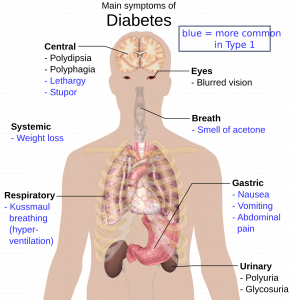
Are You At Risk?
First, it’s important to know your risk factors. Are you someone who is at a higher risk than others at developing Diabetes? You can take a quick one-minute risk assessment test here.
Gender is one risk factor. If you’re a male you are much more likely to develop type 2 diabetes. This could be related to the fact that men tend to extra weight around their middles. Obesity is the largest risk factor and responsible for over 90% of those individuals diagnosed.
Obesity is an issue, mostly because of the lifestyle habits that lead to being overweight. A sedentary lifestyle and diets high in fat and sugar are a perfect combination for diabetes. This is great news since these things are in our control to change! Simply eating more vegetables, leaner meats and reducing soda intake can go a long way in changing our bodies.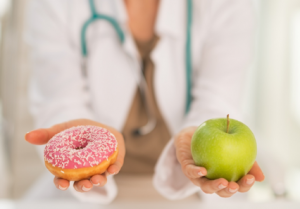
Physical activity doesn’t have to look like high-intensity circuits to achieve health. Going for thirty-minute walks a few times a week is sufficient. Look for opportunities to sneak in extra activity by parking further from the supermarket, or taking the stairs at work. These small adjustments can lead to big results in your health and reversal of pre-diabetes (People with “pre-diabetes” have higher than normal blood sugar levels, but not diabetes yet).
Other risk factors include smoking, excess alcohol, family history, poor sleep habits, high blood pressure and high cholesterol. See your doctor regularly and ask them to check your blood sugar if you have concerns.
Warning Signs of Type 2 Diabetes
- Fatigue
- Frequent Urination
- Increased Thirst
- Insatiable Hunger
- Slow-healing wounds
- Blurry Vision
- Tingling in Hands and Feet
- Frequent Yeast Infections
For more about the reasons behind these symptoms, visit the Medical News Today article that explains more. If you or someone you know is exhibiting any of these signs, make an appointment with a doctor. Diabetes that is left unchecked can lead to all sorts of health complications including heart disease, kidney disease, stroke and more. Early detection is key. For more information and resources on Diabetes Month, visit our Wellness Calendar.


